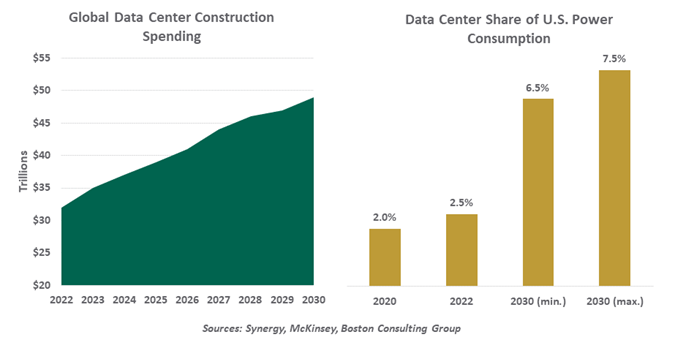by Carl R. Tannenbaum, Chief Economist, Northern Trust
AI adoption will dent the fight against climate change.
By Carl Tannenbaum
I noticed something new on the social media platforms that I use. As I compose each post, I am asked if I want to sharpen the message by using artificial intelligence (AI). Just to see how it worked, I agreed on one occasion. A simple message about the job market was transformed into a Marxian manifesto decrying the tyranny of capital over labor. I couldn’t hit the “undo” key fast enough.
Much as we might try, though, we are unlikely to escape the impact of AI. The time, attention and money that is being devoted to its development are all substantial. Another significant input to the transformation is electricity. Simply stated, AI is a power hog. According to the International Energy Agency, a ChatGPT query uses ten times more electricity than a simple Google search.
High-end analytics and machine learning perform billions of calculations in short spaces of time. Collecting and organizing the data required is also computationally demanding.
AI is a power hog.
The infrastructure required to support the process—commercial buildings filled with servers bearing sophisticated microchips—requires an immense amount of electricity. Aside from the needs of these engines, advanced cooling systems are needed to prevent them from overheating.
Construction of new data centers is at a fever pitch. Rental rates for space at existing facilities are escalating at an annual pace of close to 20%. Stress on power grids has consequently been increasing. And the shares of power generators have been gaining at a pace that is several times the appreciation of the “Magnificent Seven” stocks. Shortages of commodities like copper and water are directly attributable to the headlong drive to expand computing power.
In some areas, AI providers have arranged for dedicated supplies of electricity. Unfortunately, these sources aren’t always environmentally friendly; in parts of the world, coal-fired power plants have been put back into use to feed the demands of the technology. Other potential fuel sources are also being explored, but each has important limitations.
These developments put AI on a collision course with another economic megatrend: adapting to climate change. Long before college students were using AI to compose their essays, the world was struggling with energy policy. The problem is often called a trilemma: a situation in which there are three objectives, but only two can be coincidentally achieved. The world wants inexpensive energy; it wants clean energy; and it wants to procure energy from reliable sources without compromising geopolitical principals.
Reconciling these aims carries a very high degree of difficulty. As an example, one strategy for reducing the growth of carbon emissions is to increase the share of electric vehicles on the road. But that requires the construction of a vast network of charging stations, which will place steep demands on the electricity grid and compete with the needs of data centers.

In the United States, fossil fuels (primarily natural gas) account for 60% of energy generation. Nuclear and renewables both hover around 20%. In the short term, then, we’ll need a good deal more gas-fueled capacity; this will require more investment in a source that generates mixed feelings among investors and consumers.
AI is a power hog.
How, then, to square society’s advancing embrace of AI with its desire to control climate change? Some suggest a “physician, heal thyself” approach. Why not let AI loose on the problem, asking it to design optimal data center structure and manage peaks and troughs of power demand? AI could also potentially examine itself; there may be ways to make the algorithms that run large language models more efficient.
I will be doing my part to address the problem. After my unfortunate experience with the labor market comment, I will not use AI again anytime soon. It may not save a lot of electricity, but every little bit helps.
Copyright © Northern Trust
















